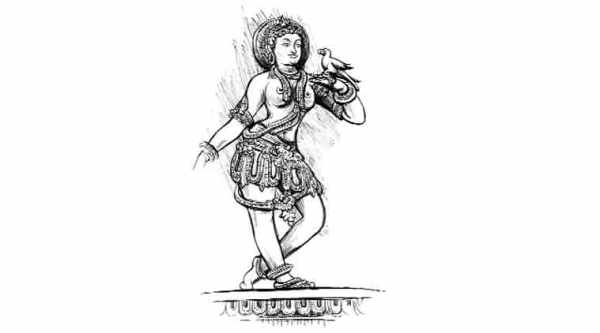- India
- International
Stolen ‘parrot lady’ sculpture surfaces in Canada
The ‘parrot lady’ is a sculpture of a naayika or heroine seen at several medieval temples in central and southern India.
 Representative drawing of a ‘parrot lady’ sculpture at the Chennakesava temple in Belur, built by the Hoysala kings who ruled Karnataka in the 12th century AD .
Representative drawing of a ‘parrot lady’ sculpture at the Chennakesava temple in Belur, built by the Hoysala kings who ruled Karnataka in the 12th century AD .
A medieval sculpture of a woman known as “parrot lady” or “parrot woman”, probably stolen from a temple in India, has been found in Canada. A team of three officials — two from the Archaeological Survey of India (ASI) and one from the Geological Survey of India (GSI) — will travel to Canada to inspect the statue and explore the possibility of bringing it back to the country.
The ASI’s Director (Antiquity), D N Dimri, told The Indian Express that Canadian investigators who intercepted the piece noticed similarities with Indian art, and alerted the Indian High Commission. “The picture they have sent us indicates clearly that the sculpture is a piece of Indian art. How the piece was stolen, from where and exactly when, and how it reached Canada, is a matter of investigation,” Dimri said.
The ‘parrot lady’ is a sculpture of a naayika or heroine seen at several medieval temples in central and southern India. The sculpture typically denotes a woman in a dancing or preening pose, talking to a parrot that is perched on her hand or shoulder, with the bird appearing as a friend (sakhaa) or confidant of the naayika.
“The ‘parrot lady’ is a certain representation of a naayika, several examples of which are known to Indian art history. It is often described as a “shukasarika”, a “shuka” being a parrot, and is seen at many early medieval temples. A woman with a parrot is an important motif in Indian literature, poetry, art and architecture,” Dr Parul Pandya Dhar, professor of art history at Delhi University, said.
“In one particular representation, a parrot is shown perched on the lady’s head, with its beak touching her hair. This is inconographically different and unusual,” Dr Dhar said.

Naayikas have been represented at Hindu, Buddhist and Jain temples, and became especially popular in the medieval period, when they began to be regarded as auspicious. “The naayikas became an object of reverence as well as a celebration of the female body,” Dhar said.
In his book Woman in Indian Sculpture, Manohar Laxman Varadpande writes that depictions of women with birds are common in the temples of Orissa and central India, especially in the Khajuraho complex. “In Indian mythology, the parrot is considered the vehicle of Cupid or Kamadeva, the God of Love,” Varadpande writes.
Apr 24: Latest News
- 01
- 02
- 03
- 04
- 05







































